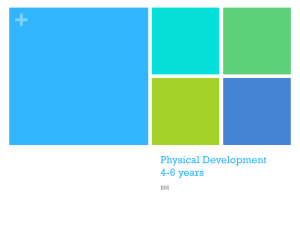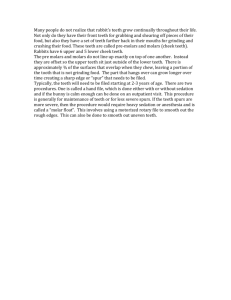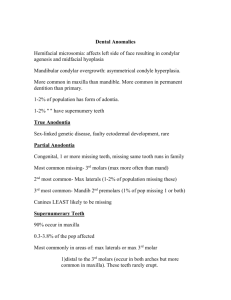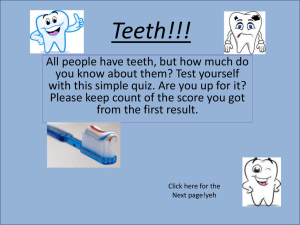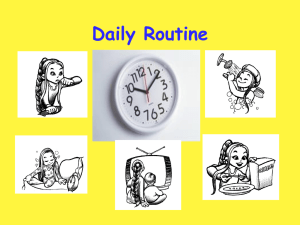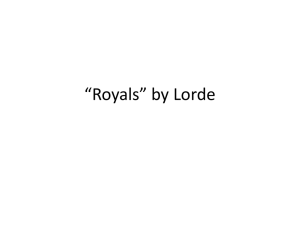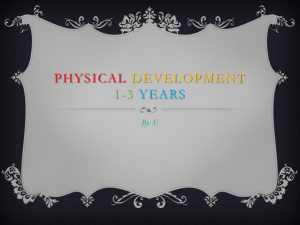Chapter 14 – Physical 4 – 6 – M
advertisement
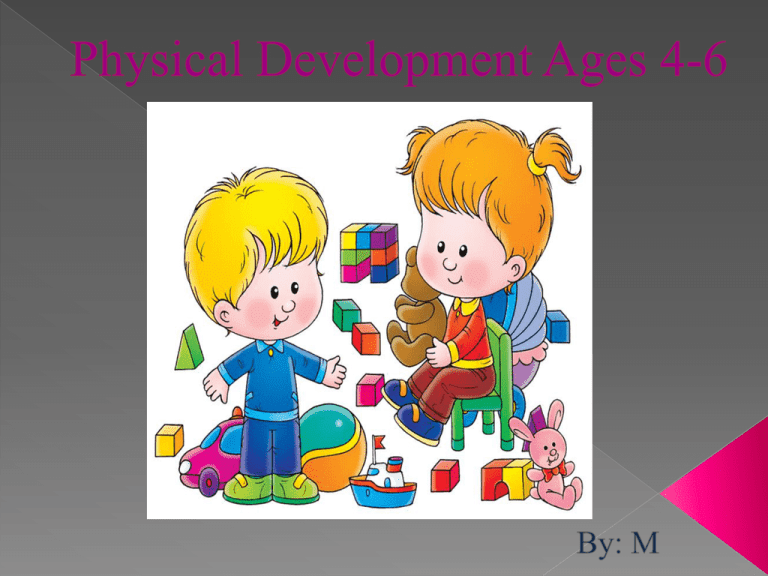
Height and weight: Growth rate from ages four to six is slightly slower than from ages one to three. The average yearly increase by height from age's four to six, is 2.5 inches to 3 inches. (6.4 to 7.6cm). Most children gain about 4 to 5 pounds (1.8 to 2.3) kg per year. Height Weight Age Inches Cm Pounds Kg Four years 40.7 103 36.0 16.3 Five years 43.5 110 40.5 18.4 Six years 46.0 117 45.0 20.4 Between ages 4-6 a child's body becomes straighter and slimmer, the protruding abdomen of the babyhood flattens, shoulders widen and the neck becomes longer. The legs lengthen and rapidly growing straighter and firmer. Childs balance and coordination improve. The movements of arms, hands and fingers become more coordinated, and the ability to do more precise work is seen each year. At age six children begin to lose permanent teeth. At that age the molars or "First Molars" are the first of the secondary teeth or appear. Those molars appear first as they act and lock to keep all other teeth in position. Later when the child's front teeth are replaced with larger secondary teeth, the molars prevent the new front teeth from pushing other teeth far back into the jaw. Most four to six year olds continue to suck their thumb, usually for self-comforting. If a child keeps sucking their thumb it can cause an effect of their teeth positioning and shape of the jaw. If child does not stop when told ask a dentist and they will recommend positive methods of stopping the habit. Four and five year olds show more improved Dexterity: The skilled use of the hands and the fingers. Average motor skills 4-6: At age 4 they learn to hop, gallop, lace shoelaces, and dresses and undresses self. Age 5: Ties shoelaces, draws/recognizes person, writes alphabets, buttons, snaps and zips clothes. Most children this age will leave out vowels. Example "dg" instead of dog and "ct" instead of cat. They also start to recognize the letters in their name through repetition of words in a classroom. Age 6: Throws and catches ball with ease and more accuracy, builds blocks/towers, writes entire word. By age five most children consistently use their right or either their left hand. The hand that is most often used for any type of activity is the hand that becomes the most skillful. Some researchers are still not certain how hand preference is developed. Others think that it depends on which hand the parents usually put objects into the first several years of life. Snacks; snacks are not bad they contribute to the child's daily needs. Snacks like cake and other sugary treats or drinks fail to supply many of the nutrients such as proteins, vitamins and minerals. Always feed your children fruits and vegetables. Poor nutrition can have a number of bad effects. Children with inadequate diets poor nourished children are easily distracted and often lack motivation to learn. Don’t feed your children too much sugary or fatty food. Teaching children about good nutrition: One research study showed how 4 and 5 year olds can be taught better eating habits. Researchers also selected 5 of the least popular vegetables which were asparagus, broccoli, rutabagas, spinach and turnips to use in the experiment. Children also helped, clean, chop and cook these vegetables for their own meal. At the end of the experiment, most children ate vegetables. Most children decrease the interest in washing, bathing, and dressing. Always provide encouragement to your child tell them that "we'll have dinner after you take a shower" or "Terrific you smell fresh and clean" this makes the child feel good about themselves and want to do it very often. Usually 4, 5, and 6 year olds know how to dress themselves independently. Some may need help with buttons or zipper down the back. When choosing clothing always make sure that; is it comfortable, or is it flexible for the child to move around in? It is necessary to have your child be comfortable in their own clothing. It is also important to let your kid choose their own clothes. Being happy with his or her outfit contributes to a child’s self confidence. Provide an Individual bed for each child usually encourages better sleep habits. Most 4,5 and 6 year olds show less reluctance to go to bed. Most children want their parents to read them a bed time story before bed, and some children need a conversation or a stuffed toy. Child Development Textbook My Aunt Motor skills/ Writing skills http://www.kidspot.com.au/schoolzone/Spelling-Spellingmilestones-5-6+3980+306+article.htm Images Google http://www.google.ca/


